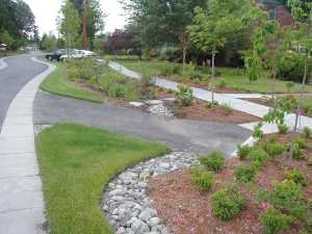Low Impact Development (LID)

Precipitation, in the forms of rainfall and snow onto impervious surfaces such as parking lots, sidewalks and streets does not filtrate back into the earth and aquifer, but rather washes the surfaces and sends the contaminants eventually to our waterways. This is known as non-point source pollution.
Low Impact Development addresses how stormwater enters a site, is temporarily stored and how the stormwater eventually exits the site. At its core, LID minimizes impervious surfaces, protects soils from compaction and erosion, promotes native vegetation and manages stormwater at its source.
As with any sustainable strategy, all aspects of synergies and tradeoffs must be considered, particularly with LEED for Neighborhood Development projects. Managing stormwater may be less practical, for instance, when considering street grids that promote walking. Streets can cause interruption to the overall stormwater management plan by disrupting the preferred release of stormwater.
Low Impact Development addresses how stormwater enters a site, is temporarily stored and how the stormwater eventually exits the site. At its core, LID minimizes impervious surfaces, protects soils from compaction and erosion, promotes native vegetation and manages stormwater at its source.
As with any sustainable strategy, all aspects of synergies and tradeoffs must be considered, particularly with LEED for Neighborhood Development projects. Managing stormwater may be less practical, for instance, when considering street grids that promote walking. Streets can cause interruption to the overall stormwater management plan by disrupting the preferred release of stormwater.

